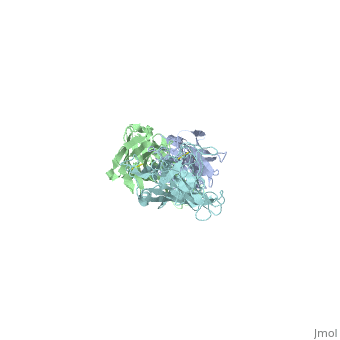G09SecL04Tpc2: Difference between revisions
Nabil Faridi (talk | contribs) No edit summary |
|||
| Line 1: | Line 1: | ||
[[Image:http://www.wadsworth.org/databank/hirez/hechemy2.gif|thumb|right| ]] | |||
Outer surface protein A (OspA) is a major [http://en.wikipedia.org/wiki/Lipoprotein lipoprotein] on the [http://en.wikipedia.org/wiki/Borrelia_burgdorferi borrelia burgdorferi] [http://en.wikipedia.org/wiki/Spirochete spirochete] which is a causative agent of Lyme Disease. The three loops in the C-terminus define the OspA antigen-antibody complex. The interaction between the loops and the LA-2 (antibody) forms the basis for OspA vaccination. Along with other surface proteins, OspA has many important functions that are associated with [http://en.wikipedia.org/wiki/Lyme_Disease Lyme Disease] such as late stage neurological disorders. | Outer surface protein A (OspA) is a major [http://en.wikipedia.org/wiki/Lipoprotein lipoprotein] on the [http://en.wikipedia.org/wiki/Borrelia_burgdorferi borrelia burgdorferi] [http://en.wikipedia.org/wiki/Spirochete spirochete] which is a causative agent of Lyme Disease. The three loops in the C-terminus define the OspA antigen-antibody complex. The interaction between the loops and the LA-2 (antibody) forms the basis for OspA vaccination. Along with other surface proteins, OspA has many important functions that are associated with [http://en.wikipedia.org/wiki/Lyme_Disease Lyme Disease] such as late stage neurological disorders. | ||
| Line 12: | Line 14: | ||
== Structure == | == Structure == | ||
== The Elusiveness of OspA == | |||
Revision as of 07:48, 16 August 2012
Outer surface protein A (OspA) is a major lipoprotein on the borrelia burgdorferi spirochete which is a causative agent of Lyme Disease. The three loops in the C-terminus define the OspA antigen-antibody complex. The interaction between the loops and the LA-2 (antibody) forms the basis for OspA vaccination. Along with other surface proteins, OspA has many important functions that are associated with Lyme Disease such as late stage neurological disorders.
Outer Surface Protein A (OspA)Outer Surface Protein A (OspA)
|
Introduction to Lyme DiseaseIntroduction to Lyme Disease
Lyme disease is the most common tick-borne disease in North American hemisphere. Responsible for transmission is a tick vector from the genus of Ixodidae. There are different bacterial strains of borrelia including B.afzellii and B.garinii being very prevalent throughout the European continent; other known strains such as B.dutonii and B. recurrentis have been discovered within the past few decades. The most common strain in the United States is borrelia burgdorgeri sensu stricto, and this treponema-like spirochete was discovered to be the causative agent of Lyme Disease discovered by Dr. William Burgdorferi in 1982 along with several other colleagues.
Besides OspA, there are other outer surface proteins, including OspB, OspC, and Vls, which are very important for the transmission of Lyme Disease from the tick to the host, as well as establishing the infection via bloodstream disseminating throughout the host body. Early symptoms of Lyme Disease include skin lesions and rashes that have a characteristic bulls-eye appearance known as erythema chronicum migrans (ECM). It is important to note that ECM can be used for early diagnosis of Lyme Disease prior to awaiting more accurate laboratory tests.
Upon infection, OspA is immediately downregulated or can even be turned off. Because of this, vaccinations for OspA are virtually ineffective once spirochetes have entered the host. Downregulation also makes OspA harder to detect; OspA is usually upregulated in the late stages of the disease and leads to more serious inflammatory disorders in the central nervous system.
